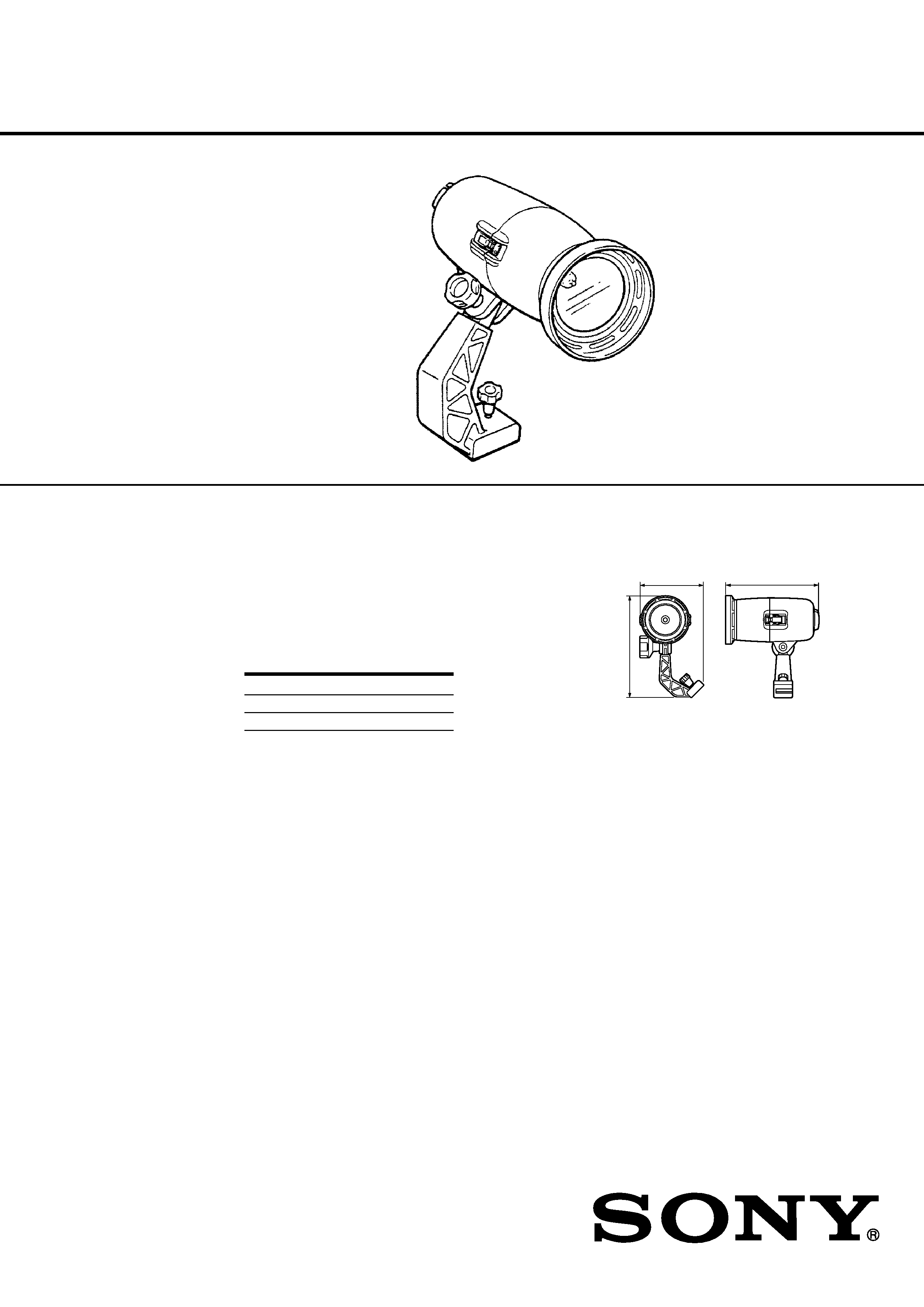
SERVICE MANUAL
UNDERWATER VIDEO LIGHT
US Model
Canadian Model
AEP Model
SPECIFICATIONS
Ver 1.1 2002. 06
HVL-ML20M
Material
Plastic (ABS, PC), glass
Waterproof facility
O-ring, 2 buckles
Usable depth Up to 75 m (246 feet)
Power requirements
Supplied from Sony NP-QM91, NP-
QM71 rechargeable battery packs
Bulb
20 W halogen lamp (1)
Continuous lighting time
Battery
Lighting time
NP-QM91
75 min.
NP-QM71
45 min.
Color temperature
3 200 K
Life of bulb
Approx. 100 hours (average)
Underwater illumination distance
Approx. 2 m (6.5 feet) (The figure
varies depending on clearness of the
water.)
Dimensions
unit: mm (inches)
145 (5 / )
3 4
223 (8 / )
7 8
242
(9
/
)
5
8
Mass
Approx. 1.7 kg (3 lb 12 oz) incl. the
arm, not incl. the battery pack
Accessories supplied
O-ring (1)
Grease (1)
Battery cushion (1)
Operating Instructions (1)
Design and specifications subject to change without
notice.
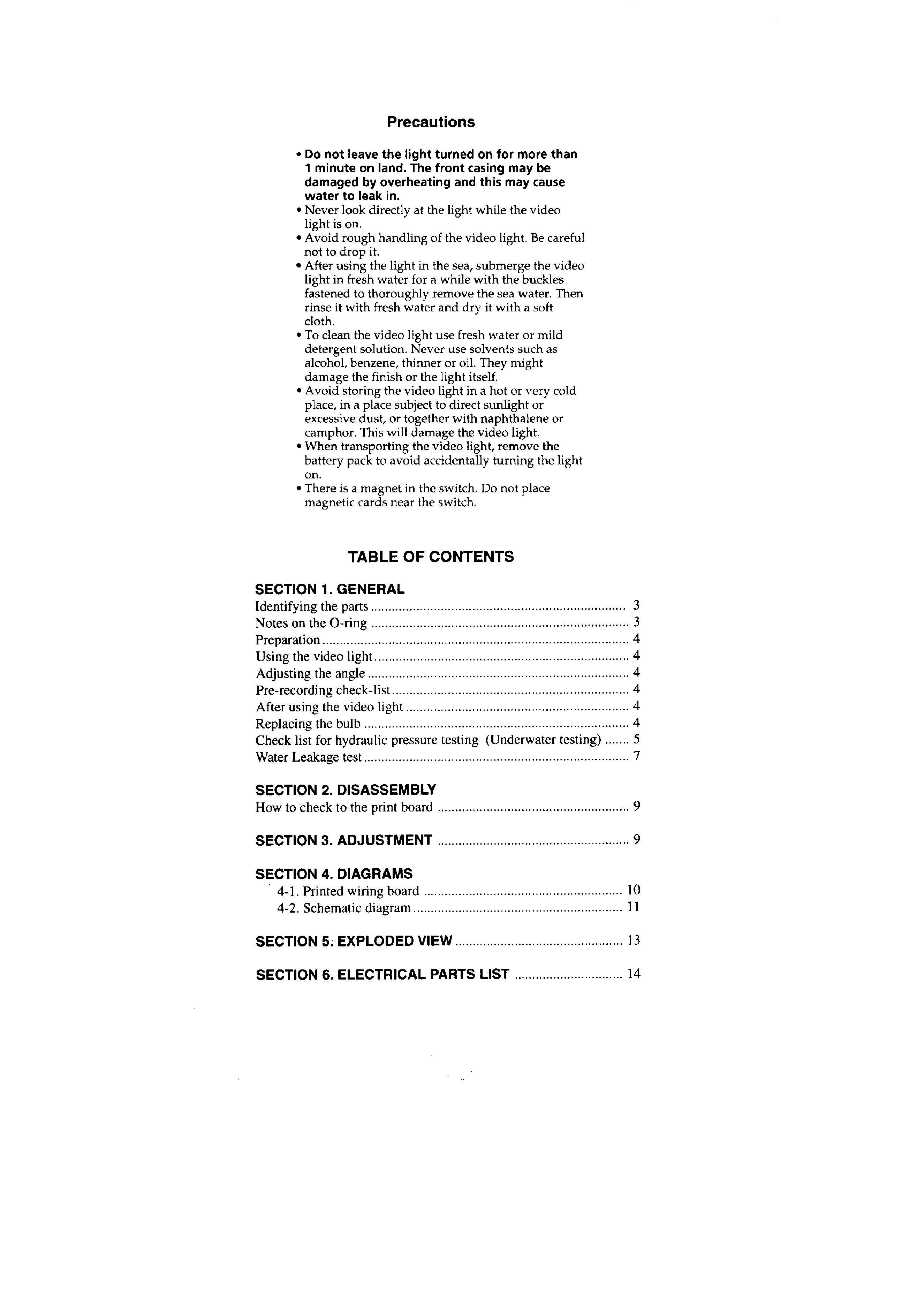
2
HVL-ML20M
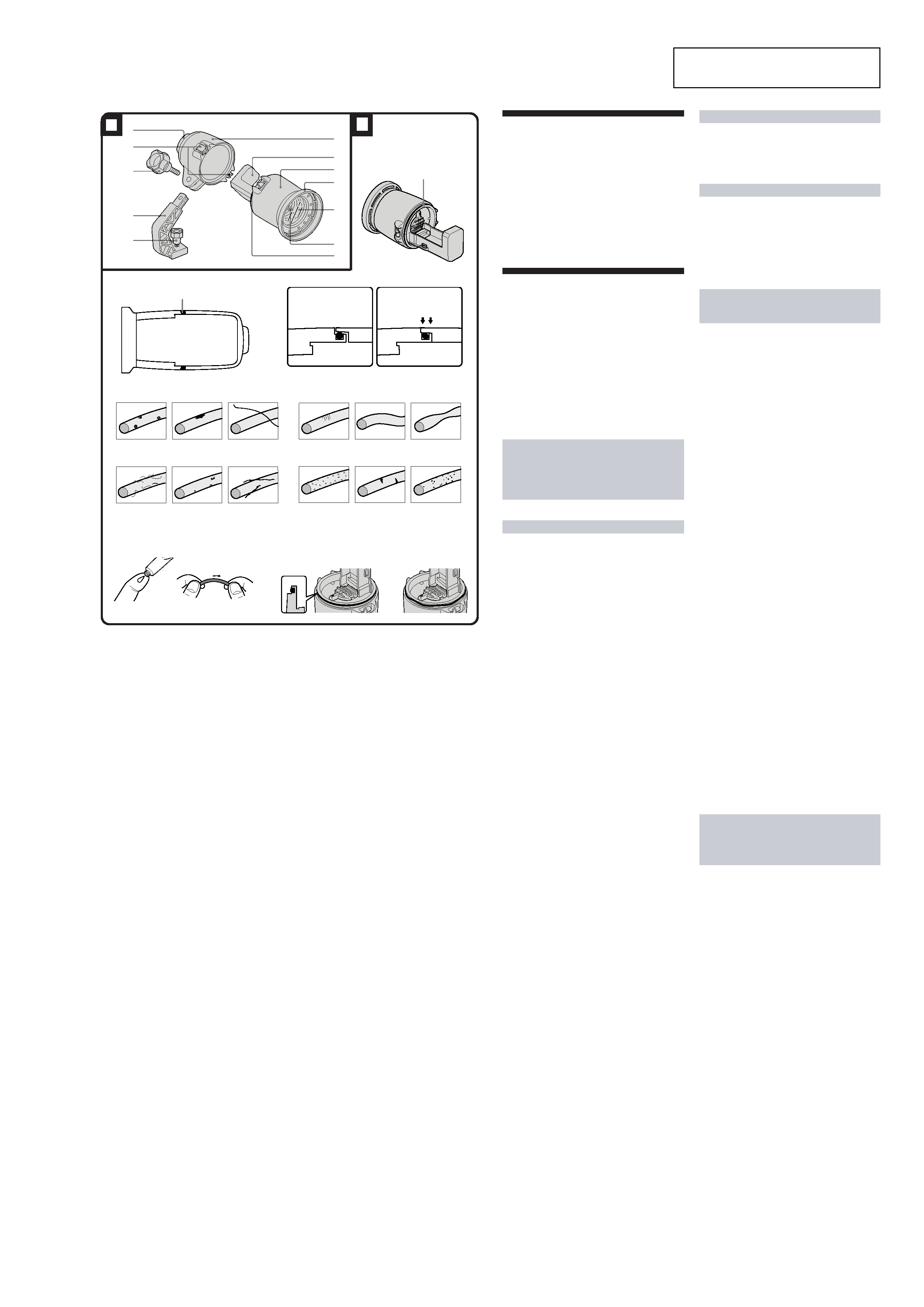
3
HVL-ML20M
SECTION 1
GENERAL
This section is extracted from
instruction manual.
A
3
1
2
4
5
7
6
8
9
q;
qa
qs
B
E
D
B
A
O-ring
F
C
O-ring
G Good example
Bad example
water
water pressure
v Dirt
v Sand
v Hair
v Dust
v Salt
v Thread scraps
v Cracking
v Skew
v Distortion
v Fine Splitting
v Scratches
v Sand-biting
A Identifying the parts
1 Power Switch
2 Buckle
3 Angle lock screw
4 Arm
5 Arm lock screw
6 Rear casing
7 Battery pack holder
8 Front casing
9 Guard
q; Front glass
qa Halogen lamp
qs O-ring
B Notes on the O-ring
What Is an O-ring? (B-A)
· An O-ring is part of the water-proof packing that is
used on underwater cameras, watches, and other
diving equipments.
· The O-ring acts to preserve the waterproof
qualities of the Marine Pack and other equipments.
How the O-ring waterproofs
The surface of the O-ring contacts the rubber to
prevent water from entering the gap. (B-B)
When water pressure acts on the O-ring, the contact
surface area of the O-ring expands to increase the
force acting on the groove on the Marine Pack.
(B-C)
O-ring maintenance is very important. If
O-ring maintenance is not followed according
to instructions, this might cause a water leak,
and cause the Marine Pack to sink. The surface
of the O-ring contacts the entire rubber evenly
to prevent water from entering the gap.
Handling the O-ring
Set the O-ring in place
Avoid setting the O-ring in dusty or sandy locations.
1 Remove the O-ring.
Do not use pointed or metal objects to remove
the O-ring. These objects might scratch or
damage the Marine Pack groove or O-ring.
2 Inspect the O-ring.
· Fully check the following, and wipe off with a
soft cloth or tissue paper. (B-D)
Check for any dirt, grains of sand, hair, dust,
salt, thread scraps, etc.
Check for any old grease.
·Lightly run your fingertip around the O-ring to
check for any unapparent dirt.
·After wiping the O-ring, take care to prevent
any cloth or tissue paper fibres from remaining
on the O-ring.
· Check the O-ring for cracking, skew, distortion,
fine splitting, scratches, sand-biting, etc.
Replace cracked or scratched O-rings.
(B-E)
3 Inspect the O-ring groove.
Grains of sand or hardened salt sometimes get
into the groove. Carefully remove them by
blowing with an air spray or by wiping them
with a cotton wool bud. Prevent fibre scraps from
the cotton wool bud from entering inside.
4 Also, inspect the contacting surface on the
other side of the O-ring in the same way.
5 Apply a coating of grease in the blue tube
to the O-ring. (B- F)
· Apply a small drop of grease onto the O-ring
and evenly coat the entire surface of the O-ring
with the end of your finger.
· Do not use paper or cloth as fibre may stick to
the O-ring.
·Make sure that a thin coating of grease is
applied to the surface of the O-ring at all times.
Grease protects the O-ring, and prevents wear.
·After you have applied a small drop of grease
onto the O-ring, set the O-ring immediately. Do
not leave the greased O-ring on a desk or other
surfaces.
6 Place the O-ring in the groove on the
Marine Pack. (B- G)
Place the O-ring evenly in its groove paying
attention to the following points:
Is there any dirt on the O-ring?
Is the O-ring twisted?
Do not pull the O-ring.
Is the O-ring protruding?
Final check
After you have fitted in the O-ring, check it again for
the following:
Is the O-ring twisted?
Is there any dirt on the O-ring?
Is the O-ring protruding?
Are there any cracking or distortion on the O-ring?
How to check for water leaks
After you have replaced the O-ring, close the Marine
Pack before you insert the equipment you are using.
Immerse the Marine Pack for about three minutes in
water to a depth of about 15 cm, and check for water
leaks.
Caution
When you have taken photos on a sandy sea bottom
or have placed the camera on the sand, remove the
O-ring and check for water leaks.
Be sure to take a spare O-ring with you.
This facilitates replacement even if O-ring
trouble occurs where you are taking photos.
Maintenance
After you have finished using an O-ring
·After you have used the Marine Pack, be sure to
perform the following:
Wash the Marine Pack with fresh water with the
buckle closed to remove salt or sand.
Insert the Marine Pack in fresh water for about 30
minutes with the buckle closed.
If salt is left on the Marine Pack, metal parts and
the O-ring might be damaged, and cause water
leaks.
When sun oil is stuck to the Marine Pack, wash
off with lukewarm water.
If sun oil is left on the Marine Pack, the surface of
the Marine Pack might become discolored or
become damaged.
Wipe the inside of the Marine Pack with a soft,
dry cloth. Do not wash with water.
·Remove the O-ring each time that you have
finished using it, and check it.
If the Marine Pack is dried with sea water still in
the O-ring groove, salt crystals form, and might
impair the O-ring's functions.
· Do not use thinner, benzene, alcohol or other
solvents as they will damage the surface finish.
Storing O-rings
· Attach the spacer that was attached when you
purchased the O-ring to prevent the O-ring from
deteriorating.
· Prevent dust from sticking to O-rings.
· Apply a thin coating of grease in the blue tube to
the O-ring, set it in the groove, and store in a well-
ventilated location. Do not close the buckle.
· Avoid storing O-rings in hot, cold or humid
locations, and placing in naphthalene or camphor.
These locations and solutions will damage the
materials.
How to store O-rings
·To maintain the O-ring's functions, avoid storing
them in hot locations or in the direct sunlight.
· Do not place the spare O-ring under heavy objects.
Doing so might deform the O-ring.
O-ring life
Replace the O-ring with a new one after one year of
use.
Even if the O-ring is not cracked or scratched,
deformation or wear reduces the waterproof
qualities of the O-ring. Replace the O-ring with a
new one if cracking, skew, distortion, fine splitting,
scratches, sand-biting, etc. is found.
Grease
Use the grease in the blue tube (supplied).
Using the grease in the yellow tube or other
manufacturer's grease will damage the O-ring,
and cause water leaks.
O-ring and grease
Contact your nearest Sony Service Center.
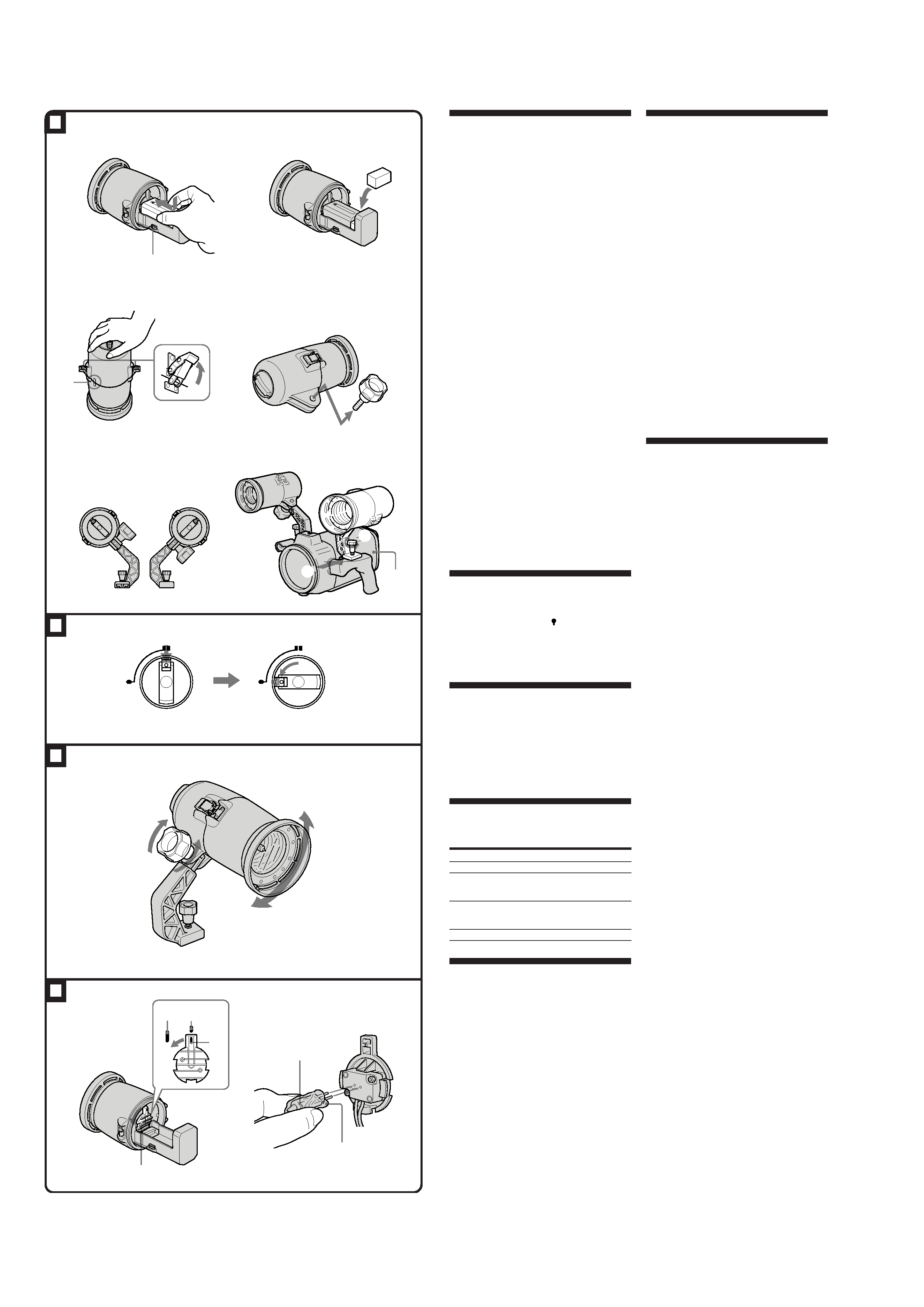
4
HVL-ML20M
C Preparation
1 Charge the battery pack (not supplied).
Use the Sony NP-QM91 or NP-QM71
rechargeable battery packs provided for video
cameras.
Refer to the operating instructions of the video
camera regarding the battery charging.
Note
You cannot operate this unit with the Sony NP-FM30
and NP-FM50.
2Install the charged battery pack.
Attach the charged battery pack and slide in the
direction of the arrow until it clicks.
To remove the battery
While pressing the battery release lever A, slide
the battery in the opposite direction to when
installed.
3Attach the battery cushion B.
The battery may come loose if dropped or
subjected to impacts, so insert the cushion as
shown here.
4 Check the O-ring.
5Align the marks C on the front and rear
casings, then fasten the two buckles.
Press down the rear casing towards the front
casing and fasten the buckles.
6Attach the arm.
1
Turn and remove the angle lock screw.
2
Insert the arm and turn the angle lock
screw to secure the arm.
The two arm positions can be selected
depending on the direction in which the arm
is inserted.
7Attach the video light to the Marine Pack
(not supplied).
1
Loosen the arm lock screw.
2
Insert the arm bracket into the accessory
shoe of the Marine Pack D.
Tighten the arm lock screw.
D Using the video light
While pressing the upper knob, turn the power
switch counterclockwise from the LOCK position
until the white dot meets the
mark.
To turn off the light
Turn the power switch clockwise to the LOCK
position.
E Adjusting the angle
1 Loosen the angle lock screw.
2 Adjust the angle of the video light so that
the object is illuminated.
3Tighten the angle lock screw to fix the
angle.
Pre-recording check-list
Before diving, check if the light can be turned on and
go over the following checklist.
Item
Checkpoints
Battery pack
· Fully charged.
Bulb
· Not burnt out.
· Correctly plugged into the bulb
socket.
O-ring
· No scratches or cracks.
·No dust, sand or hair around it.
· Correctly placed in the groove.
Buckles
· Correctly fastened.
After using the video
light
1With the buckles fastened, thoroughly
wash the video light with fresh water.
2Dry the video light and your hands so that
no moisture gets inside.
When opening the casing make sure your hands
are dry. Water dripping into the casings may
damage the video light.
3 Unfasten the two buckles.
4 Open the front and rear casings.
5 Remove the battery pack.
Note
After using this unit in the sea, immerse it in fresh
water with the buckles fastened for a few minutes in
order to remove salt. Then, perform all the above.
C
D
23
O
N
/O
FF
LOCK
O
N
/O
FF
LOCK
E
F
3
1
2
24
I
H
6
1
2
A
F
E
G
J
F Replacing the bulb
For replacement, always use the Sony halogen lamp
(1-518-691-11). To replace the new bulb, contact your
nearest Sony Service Center or Sony Shop.
1 Open the casing and remove tf`battery
pack.
2 Pull out the bulb socket gently.
Turn the socket lever E counterclockwise to the
release positon F and pull out the bulb socket G
gently from the front casing.
3 Remove the old bulb from the socket.
The bulb is hot when it has just burned out. Wait
until the bulb cools down before removing it.
4Plug in the new bulb (not supplied) gently.
H
New bulb
I
Plastic bag
To prevent the bulb from being smudged with
finger prints, plug in the bulb holding it with a
plastic bag or a dry cloth. If the bulb is smudged,
the light may smoke when it is turned on or the
bulb life may be shortened. If you have touched
the bulb surface, clean it completely.
Do not plug the bulb into the socket forcibly.
5 Replace the bulb socket to the front casing.
Replace the bulb socket to the front casing, then
turn the socket lever clockwise to the lock
position J.
Precautions
· Do not leave the light turned on for more than
1 minute on land. The front casing may be
damaged by overheating and this may cause
water to leak in.
·Never look directly at the light while the video
light is on.
·Avoid rough handling of the video light. Be careful
not to drop it.
·After using the light in the sea, submerge the video
light in fresh water for a while with the buckles
fastened to thoroughly remove the sea water. Then
rinse it with fresh water and dry it with a soft
cloth.
·To clean the video light use fresh water or mild
detergent solution. Never use solvents such as
alcohol, benzene, thinner or oil. They might
damage the finish or the light itself.
·Avoid storing the video light in a hot or very cold
place, in a place subject to direct sunlight or
excessive dust, or together with naphthalene or
camphor. This will damage the video light.
·When transporting the video light, remove the
battery pack to avoid accidentally turning the light
on.
· There is a magnet in the switch. Do not place
magnetic cards near the switch.
D
7
5
6
C
B
1
2
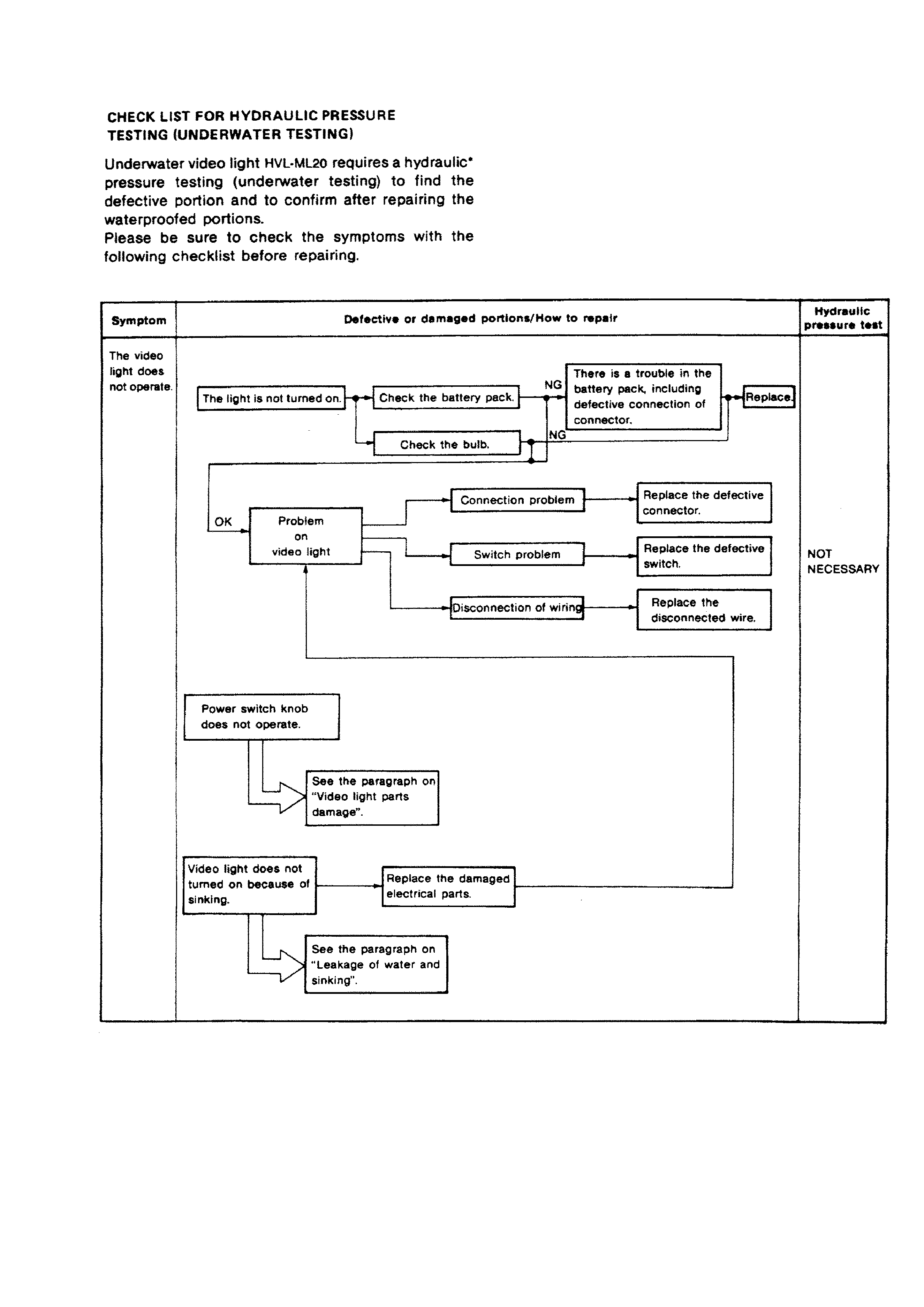
5
HVL-ML20M
